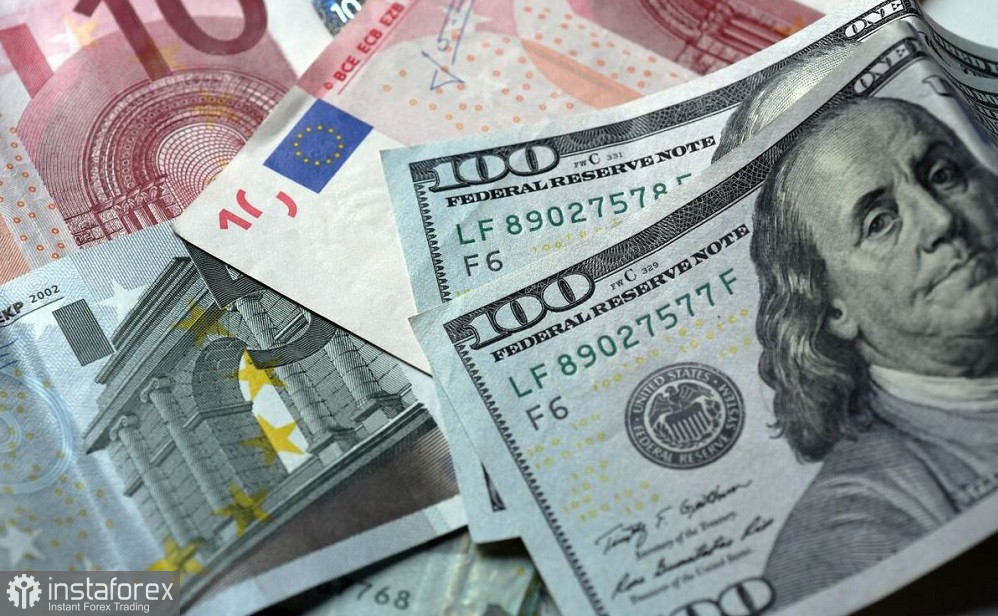The EUR/USD pair kicked off the trading week on Monday by trying to settle above the intermediate resistance level of 1.0840 (the Tenkan-sen line on the daily chart and simultaneously the middle line of the Bollinger Bands on the weekly timeframe), against the backdrop of a relatively quiet economic calendar.
The Sentix investor confidence indicator, reflecting investors' trust in the eurozone economy, entered the "green," providing some support to the euro. The indicator has been in the negative territory since March 2022, signaling pessimism among investors. However, the index has been showing an upward trend since November 2023. The current month is no exception: the indicator reached -10.5 in March (against a forecast of -10.8 points). For comparison, it was at -21.9 points in October.

However, take note that this secondary macroeconomic indicator only had an indirect impact on the dynamics of EUR/USD. The pair grew primarily due to the greenback's broad weakness. The US Dollar Index is falling, after the release of the ISM Manufacturing Index, as it follows the momentum of Friday's trading session. This index actively rose over the last two months, increasing from 46 points to 49. According to forecasts, the index was expected to return to the expansion point in February, i.e., to be above the key mark of 50.0. Instead, the indicator fell to 47.8, suggesting that the situation is becoming more difficult: demand slowed down, and production volume declined.
The report indicates the general weakness of the American manufacturing sector. In particular, the New Orders Index ended up in the contraction point, decreasing to 49.2, whereas in January, this component was at 52.5. A similar situation arose with the Manufacturing Index, which dropped to 48.4 points, while in the previous month, it was in the expansion zone (50.4 points). The Employment Index also significantly decreased. This component of the report dropped to 45.9 points, whereas in January, it was at 47.1. However, inflationary pressure is becoming more stable: the Price Index reached 52.5 – almost the same level as in January (when it reached 52.9 points).
The ISM Manufacturing Index undermined the positions of the dollar bulls. Thanks to this release, EUR/USD buyers were able to seize the initiative on Friday and pull the pair towards the middle of the 8th figure. Monday's bullish momentum is a reflection of Friday's trading, as the economic calendar on Monday was relatively quiet.
Should we trust the pair's growth on Monday? In my opinion, no. At least not until the price surpasses the resistance level of 1.0890 (the upper line of the Bollinger Bands on the daily chart) and firmly settles above the target of 1.0910 (the lower boundary of the Kumo cloud on the same timeframe). In other words, until the price settles within the 9th figure. The bulls have repeatedly tried to approach the barrier of 1.0900, but each time they lost momentum. Therefore, an "active and impulsive" rise within the 8th figure means nothing – the pair has been hovering in the range of 1.0810-1.0890 for the second week.
Traders need a powerful impetus for a surge, while the first days of this week are empty and uninformative. Information will start to pour in on Wednesday when Federal Reserve Chairman Jerome Powell speaks to the US House of Representatives with a semi-annual report. Then, the European Central Bank's March meeting will take place on Thursday, and the head of the Fed will speak in the Senate. Finally, the February Non-Farm Payrolls will be released on Friday – key data on the US labor market.
It's not surprising that in anticipation of such "festivities," traders will not risk opening large positions – neither to the upside nor to the downside. After all, by the end of the week, the fundamental picture for EUR/USD could go through significant changes.
For instance, the ECB significantly softens its stance, which has certain prerequisites (soft comments from many officials, a slowdown in eurozone inflation, a slowdown in wage growth in the eurozone in the 4th quarter). At the same time, Powell may articulate a "moderately hawkish" position in Congress, as many Fed officials have been doing lately (including Christopher Waller, Susan Collins, Raphael Bostic, Jeffrey Schmidt, Michael Barr). The main thing is that the central bank should not rush to ease monetary policy. The Fed is gradually pushing the "X hour" further and further. For instance, if in December the market was almost certain that the Fed would lower rates in March, now the market is 100% sure that this will not happen. The probability of a rate cut in May is 20%. June prospects are estimated as 50/50. Powell's rhetoric can either push the "X hour" even further (to July or September) or strengthen the market's confidence that the Fed will start easing monetary policy. Depending on the tone of his rhetoric, the dollar will either strengthen its positions or come under pressure again.
Therefore, there is still uncertainty around it, amid an almost empty economic calendar and ahead of important fundamental events. You may consider long positions, but only above 1.0890 (and to be certain – above 1.0910), while shorts are only advisable after EUR/USD bears firmly settle below the target of 1.0780 (the middle line of the Bollinger Bands on the daily chart).





















